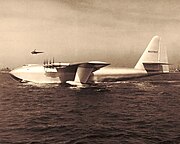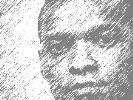Hughes was a lifelong aircraft enthusiast, pilot, and self-taught aircraft engineer. At Rogers Airport in Los Angeles, he learned to fly from pioneer aviators, including Moye Stephens. He set many world records and designed and built several aircraft himself while heading Hughes Aircraft. The most technologically important aircraft he designed was the Hughes H-1 Racer. On 13 September 1935, Hughes, flying the H-1, set the airspeed record of 352 mph (566 km/h) over his test course near Santa Ana, California. The previous record was 314 mph (505 km/h). A year and a half later, (19 January 1937), flying a somewhat re-designed H-1 Racer, Hughes set a new transcontinental airspeed record by flying non-stop from Los Angeles to New York City in 7 hours, 28 minutes and 25 seconds (beating his own previous record of 9 hours, 27 minutes). His average speed over the flight was 322 mph (518 km/h).[10]
The H-1 Racer featured a number of design innovations: it had retractable landing gear and all rivets and joints set flush into the body of the aircraft to reduce drag. The H-1 Racer is thought to have influenced the design of a number of World War II fighters such as the Mitsubishi Zero, the Focke-Wulf FW190 and the F6F Hellcat;[11] although that has never been proven. The H-1 Racer was donated to the Smithsonian in 1975 and is on display at the National Air and Space Museum.
On 10 July 1938 Hughes set another record by completing a flight around the world in just 91 hours (3 days, 19 hours), beating the previous record by more than four days. For this flight he did not fly an aircraft of his own design but a Lockheed Super Electra (a twin-engine transport with a four-man crew) fitted with all of the latest radio and navigational equipment. Hughes wanted the flight to be a triumph of technology, illustrating that safe, long-distance air travel was possible. In 1938, the William P. Hobby Airport in Houston, Texas, known at the time as Houston Municipal Airport, was re-named "Howard Hughes Airport," but the name was changed back after people objected to naming the airport after a living person.
Hughes received many awards as an aviator, including the Harmon Trophy in 1936 and 1938, the Collier Trophy in 1938, the Octave Chanute Award in 1940, and a special Congressional Gold Medal in 1939 "...in recognition of the achievements of Howard Hughes in advancing the science of aviation and thus bringing great credit to his country throughout the world." According to his obituary in the New York Times, Hughes never bothered to come to Washington to pick up the Congressional Gold Medal. It was eventually mailed to him by President Harry S. Truman.
Fatal crash of the XF-11
The second XF-11 prototype (with conventional propellers).
Hughes checking the first XF-11 prototype (with the original twin propeller design).
Hughes was involved in a near-fatal aircraft accident on 7 July 1946, while piloting the experimental U.S. Army spyplane XF-11 over Los Angeles. An oil leak caused one of the counter-rotating propellers to reverse its pitch, making the aircraft yaw sharply. Hughes tried to save the craft by landing it on the Los Angeles Country Club golf course (incorrectly stated as the Wilshire Country Club in the 2004 movie), but seconds before he reached his attempted destination, the XF-11 started dropping dramatically and crashed in the Beverly Hills neighborhood surrounding the country club.[12]
When the XF-11 finally skidded to a halt after mowing down three houses, the fuel tanks exploded, setting fire to the aircraft and a nearby home. Hughes lay seriously injured beside the burning XF-11 until he was rescued by Marine Master Sergeant William L. Durkin, who happened to be in the area visiting friends. Hughes sustained significant injuries in the crash; including a crushed collar bone, 24 broken ribs [13] and numerous third-degree burns.
However, Hughes was proud of the fact that his mind was still working. Also, as he lay in his hospital bed, he noted that he did not like the design of his bed. He called in plant engineers to design a "tailor-made" bed, equipped with hot and cold running water, built in six sections, and operated by 30 electric motors, with push-button adjustments. [14]
Many attribute his long-term addiction to opiates to his use of morphine as a painkiller during his convalescence. The trademark moustache he wore afterwards was meant to cover a scar on his upper lip resulting from the accident.
Hughes H-4 Hercules
The H-4 Hercules with Hughes at the controls
Possibly his most famous aircraft project was the H-4 Hercules, nicknamed the "Spruce Goose" (to Hughes' consternation, since its frame was built of birch, not spruce). The aircraft was originally contracted by the U.S. government for use in World War II, as a viable way to transport troops and equipment across the Atlantic instead of sea going troop transports that were liable to the threat of German U-Boats. In 1947, it was the largest aircraft ever built, weighing 190 tons and not completed until just after the end of World War II. The Hercules flew only once for a mile (1.6 km) (with Hughes at the controls) on 2 November 1947.
Confusion still exists as to whether or not the Hercules is still, in fact, the world's largest aircraft. To say it is the largest aircraft ever built is slightly inaccurate. An aircraft's size can be judged by length, weight, or wingspan. The Hercules is certainly not the longest aircraft ever built. Indeed, several airships have surpassed 800 ft (240 m). Also, despite its immense size, the Hercules weighs much less than many commercial jet liners. Measured by wingspan, however, the Hercules is greater than anything built before or since. It is the only aircraft ever built with a wingspan in excess of 300 feet (90 m), the next largest wingspan being about 30 ft (9 m) shorter.
Hughes was summoned to testify before the Senate War Investigating Committee to explain why the aircraft had not been delivered to the United States Army Air Forces during the war, but the committee disbanded without releasing a final report. Because the contract required the aircraft to be built of "non-strategic materials," Hughes built the aircraft largely from birch (rather than aluminum) in his Westchester, California facility to fulfill his contract. The aircraft was on display alongside the RMS Queen Mary in Long Beach, California for many years before being moved to McMinnville, Oregon, where it is now part of the Evergreen Aviation Museum.
Hughes Aircraft
Hughes Aircraft Company, a division of Hughes Tool Company, was originally founded by Hughes in 1932, in a rented corner of a Lockheed Aircraft Corporation hangar in Burbank, California, to carry out the expensive conversion of a military aircraft into the H-1 racer. During and after World War II, Hughes fashioned his company into a major defense contractor. The Hughes Helicopters division started in 1947 when helicopter manufacturer Kellett sold their latest design to Hughes for production.
In 1948, Hughes created a new division of the company, the Hughes Aerospace Group. The Hughes Space and Communications Group and the Hughes Space Systems Division were later spun off in 1948 to form their own divisions and ultimately became the Hughes Space and Communications Company in 1961. In 1953, Howard Hughes gave all his stock in the Hughes Aircraft Company to the newly formed Howard Hughes Medical Institute, thereby turning the aerospace and defense contractor into a tax-exempt charity. The Howard Hughes Medical Institute sold Hughes Aircraft in 1985 to General Motors for $5.2 billion. In 1997 General Motors sold Hughes Aircraft to Raytheon and in 2000 sold Hughes Space & Communications to Boeing. Boeing, GM, and Raytheon acquired the Hughes Research Laboratories.
The Airlines
In 1939, at the urging of Jack Frye, president of TWA, Hughes quietly purchased a majority share of TWA stock for nearly $7 million and took control of the airline. Upon assuming ownership of TWA, Hughes was prohibited by federal law from building his own aircraft. Seeking an aircraft that would perform better than TWA's fleet of Boeing 307 Stratoliners, Hughes approached Boeing's competitor, Lockheed. Hughes already had a good relationship with Lockheed since they had built the aircraft he used in his record flight around the world in 1938. Lockheed agreed to Hughes' request that the new aircraft be built in absolute secrecy. The result was the revolutionary Constellation and TWA purchased the first 40 of the new airliners off the production line.
Lockheed Constellation
Hughes' ownership of and plans for TWA may have been the real reason he was investigated by the Senate following the war. Pan American World Airways chief Juan Trippe sought to monopolize international air travel and had influenced powerful Maine Senator Owen Brewster to propose legislation securing Pan Am as the sole American airline allowed to fly overseas at a time when Hughes planned TWA service to Europe with the Constellation. Dietrich wrote of the investigation that Hughes beat the Senate committee by turning the hearings into an attack on Brewster. Hughes successfully exposed Brewster's dealings with Pan Am and later helped defeat his re-election bid by pouring considerable funds into the campaign of his opponent, Frederick Payne.
In 1956, Hughes placed an order for 63 Convair 880s for TWA at a cost of $400 million. Although Hughes was extremely wealthy at this time, outside creditors demanded that Hughes relinquish control of TWA in return for providing the money. In 1960, Hughes was ultimately forced out of TWA, although he still owned 78 percent of the company and battled to regain control.
Before Hughes' ouster, the TWA jet financing issue precipitated the end of Hughes' relationship with Noah Dietrich. Dietrich remembered Hughes developing a plan by which Hughes Tool Company profits were to be inflated in order to sell the company for a windfall that would pay the bills for the 880s. Dietrich agreed to go to Texas to implement the plan on the condition that Hughes agreed to a capital gains arrangement he had long promised Dietrich. When Hughes balked, Dietrich resigned immediately. "Noah," Dietrich quoted Hughes as replying, "I cannot exist without you!" Dietrich stood firm and eventually had to sue to retrieve personal possessions from his office after Hughes ordered it locked.
In 1966, he was forced by a U.S. federal court to sell his shares in TWA due to concerns over conflict of interest between his ownership of both TWA and Hughes Aircraft. The sale of his TWA shares netted him a profit of $547 million. During the 1970s, Hughes went back into the airline business, buying the airline Air West and renaming it Hughes Airwest.








No comments:
Post a Comment